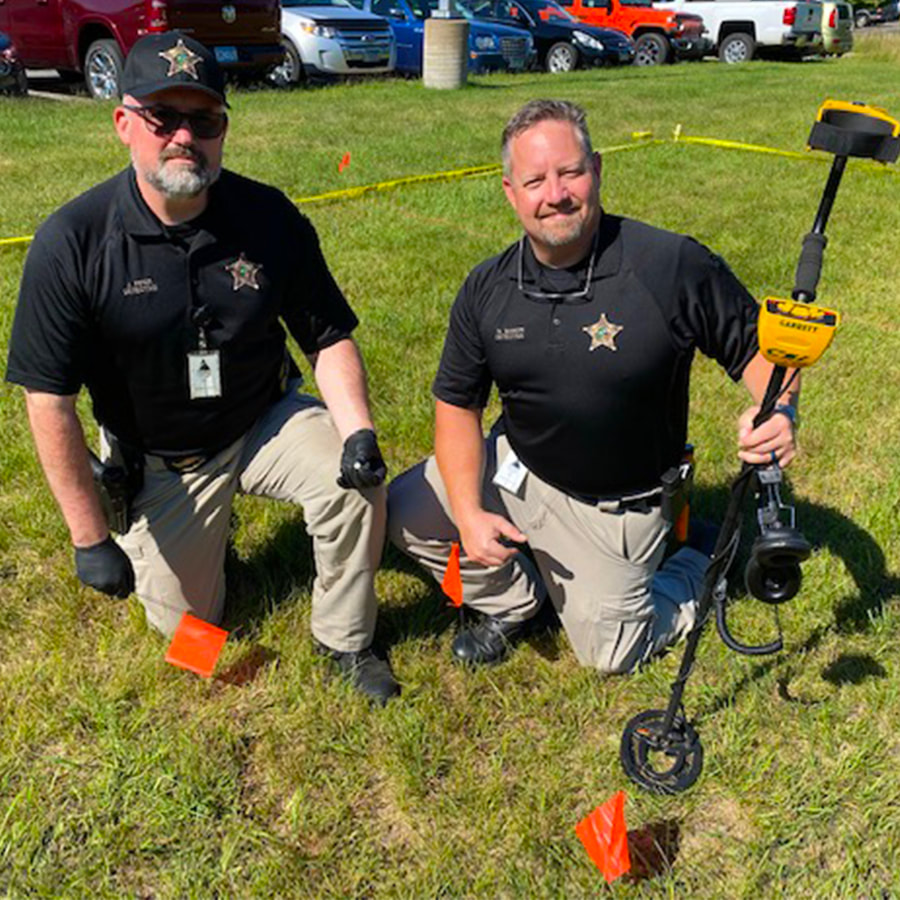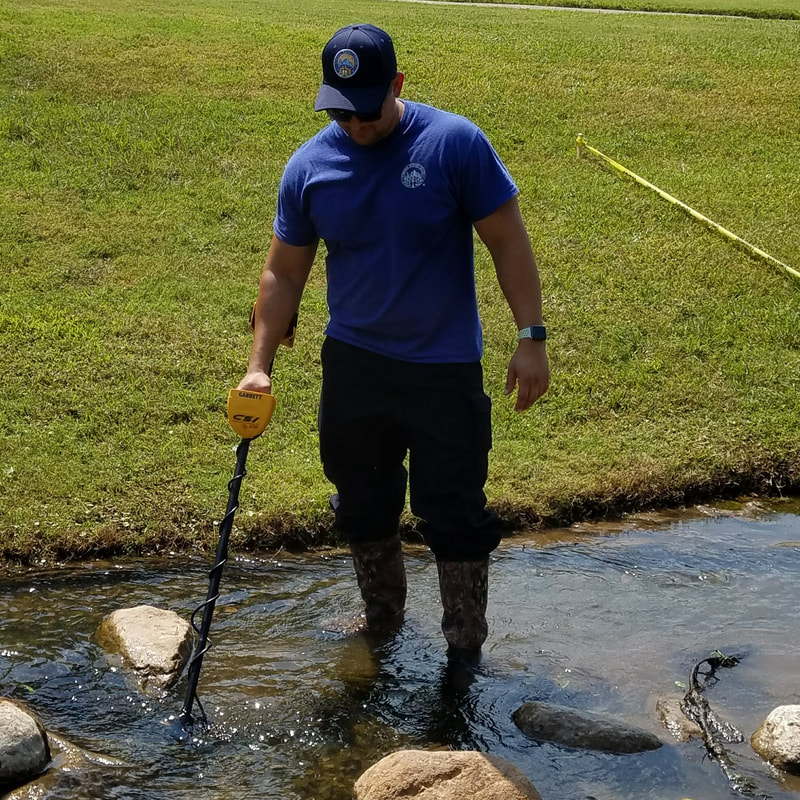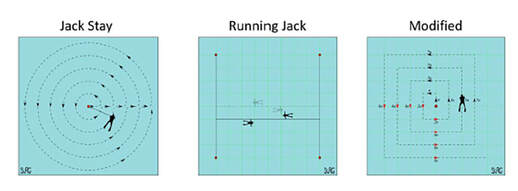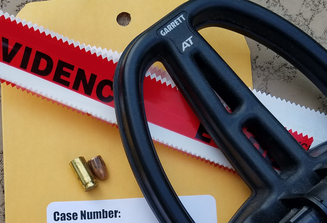Forensic Metal Detecting |
Originally published in Western and Eastern Treasures, July 2021, the article below is an abridged version of the downloadable pdf above.
By Bill Paxton
By Bill Paxton
|
If you’re like me, I’m sure every time that you watch some sort of police show on TV where the cops come in to search the crime scene with a metal detector, you have one of two reactions. Either you burst out laughing when you see the police metal detecting “expert” swinging some ten cent garage sale variety machine a foot over the ground, or your head hurts when you hear the “beeping” while they are searching that sounds like a microwave timer counting down. It really is both amusing and irritating that these shows that profess to be based upon real cases and procedures haven’t a clue as to how a metal detector really works or is used in the field.
You may not know this, but there exists within our hobby a type of metal detecting specifically designed for exactly these sorts of situations. It is referred to as “crime scene metal detector operations” or most often as “forensic metal detecting.” Never heard of it? Well, I had never heard of it either until I spoke with the owner of XTREME Scoops (www.extremescoops.com), John Volek (shown right). I was writing an article on sand scoops and called XTREME Scoops to get some information on their line of scoops. |
Not only was I surprised to have my call answered by a human being, but it also turned out to be John himself! In the course of our conversation about sand scoops, including discussing his state of the art titanium scoop, the Surf Master X2, John mentioned that he taught courses in what he called “forensic metal detecting.” Needless to say, that caught my ear and I had to know more. While my priority at the time was my scoops article, I made a note to contact John at a later date to find out more about forensic metal detecting.
It took a few months but I was finally able to connect with John. We kept trying but he is one busy guy! Not only does he run XTREME Scoops, but he also is a full-time police lieutenant with the Sugar Land, Texas, Police Department. Add to that the following:
Prior to John’s involvement in this area, crime scene metal detecting was most times a scattershot approach involving either local hunters as volunteers or police officers trying their best to master a metal detector on the fly while performing all of their other duties. John saw a need for both a refining and a “defining” of this process. It began with a simple referral from his YouTube Channel to the Houston Police Department Dive Team in the early 2000’s. The members of this team had received six Garrett Sea Hunter metal detectors and needed someone to show them how to use them. John came on board and created a two day course that focused on both land and water hunting. Along with this he refined the search grid that the team used when searching underwater that resulted in their being able to thoroughly search underwater crime scenes without missing anything.
As the old saying goes, good news travels fast. This success lead John to working with the Houston Police Department Forensic Unit which later evolved into the standalone Forensic Science Center. John continued to refine and expand this newly created area of expertise, building out a method that he felt could bring a new dimension and skill set to forensic teams across the country.
Enter Tri-Tech Forensics, a world leader in forensics, that offered training in just about every area of forensics you can imagine. Except forensic metal detecting, that is. One conversation with John, and he was instantly added to their large staff of forensic instructors. John now travels the country instructing police departments and forensic teams in his proven methods of forensic metal detecting.
In his course, while not giving away his secrets, John guides his classes through a very extensive eleven part program that begins with the basic operation of a metal detector, followed by an understanding of crime scene assessment, interview (firsthand account), proper search grid and techniques, and ends with a focus on using a metal detector specifically at several mock crime scenes. [...]
I know this seems like a ton of information, but when you think about it, what John is teaching specific to forensic metal detecting has a lot in common with what we as recreational detectorists do when we go to hunt new areas. For example, John begins at a very logical starting point: learning the metal detector that you will be operating. As you can see from the rather humorous photos accompanying this article [see images in downloadable pdf], some of the officers clearly needed John’s course prior to hunting. But how different is that from the hunter who was so anxious to use a new detector that he/she ran right out to use it without even reading the owner’s manual?
It took a few months but I was finally able to connect with John. We kept trying but he is one busy guy! Not only does he run XTREME Scoops, but he also is a full-time police lieutenant with the Sugar Land, Texas, Police Department. Add to that the following:
- John runs his own metal detecting site, Houston Metal Detecting Services, that handles everything from lost ring and personal item recovery to detector training (https://www.houston-metaldetectingser-vices.com/home.html).
- He is also a professional instructor who specializes in teaching forensic metal detecting, traveling the country for Tri-Tech Forensics (https://www.tritechtraining.com/crime-scene-metal-detector-operations.html).
- And he is a beekeeper!
Prior to John’s involvement in this area, crime scene metal detecting was most times a scattershot approach involving either local hunters as volunteers or police officers trying their best to master a metal detector on the fly while performing all of their other duties. John saw a need for both a refining and a “defining” of this process. It began with a simple referral from his YouTube Channel to the Houston Police Department Dive Team in the early 2000’s. The members of this team had received six Garrett Sea Hunter metal detectors and needed someone to show them how to use them. John came on board and created a two day course that focused on both land and water hunting. Along with this he refined the search grid that the team used when searching underwater that resulted in their being able to thoroughly search underwater crime scenes without missing anything.
As the old saying goes, good news travels fast. This success lead John to working with the Houston Police Department Forensic Unit which later evolved into the standalone Forensic Science Center. John continued to refine and expand this newly created area of expertise, building out a method that he felt could bring a new dimension and skill set to forensic teams across the country.
Enter Tri-Tech Forensics, a world leader in forensics, that offered training in just about every area of forensics you can imagine. Except forensic metal detecting, that is. One conversation with John, and he was instantly added to their large staff of forensic instructors. John now travels the country instructing police departments and forensic teams in his proven methods of forensic metal detecting.
In his course, while not giving away his secrets, John guides his classes through a very extensive eleven part program that begins with the basic operation of a metal detector, followed by an understanding of crime scene assessment, interview (firsthand account), proper search grid and techniques, and ends with a focus on using a metal detector specifically at several mock crime scenes. [...]
I know this seems like a ton of information, but when you think about it, what John is teaching specific to forensic metal detecting has a lot in common with what we as recreational detectorists do when we go to hunt new areas. For example, John begins at a very logical starting point: learning the metal detector that you will be operating. As you can see from the rather humorous photos accompanying this article [see images in downloadable pdf], some of the officers clearly needed John’s course prior to hunting. But how different is that from the hunter who was so anxious to use a new detector that he/she ran right out to use it without even reading the owner’s manual?
|
Let’s take this a few steps further. When you arrive at an area to hunt, what is the first thing that you do? Assess the area perhaps? You go to a site and figure out the best areas to hunt with the greatest potential for finding good targets. In forensic metal detecting, the crime scene is the environment and it needs to be accessed in the same way plus taking into consideration additional safety factors such as contaminates and blood borne pathogens. John recommends that officers who may encounter these sort of high risk environments use a bootie to protect their search coils from contamination.
|
Lighting is also a key safety concern since most crime scene investigation takes place after hours; headlamps are a must for these types of conditions.
Next up is what John refers to as the interview process. The “who, what, where, when, why and how” of evaluating a search environment. Very much like speaking to a property owner at a new permission, or a party who lost a valuable ring at the beach, right? Just a lot more detailed and complex.
Now we come to the subject of how to search a crime scene. Since the primary purpose of forensic metal detecting is to find metallic evidence, this is perhaps the most crucial phase. Without complete coverage of an area a vital piece of evidence could be missed. John has devised several unique gridding methods for both land and water environments, including a hybrid land/water method, to ensure that an area is completely covered. For those of us who hunt recreationally, this is gridding of the highest order!
Finally, the last part of John’s presentation is to have the officers hunt several mock crime scenes. Does that sound vaguely like having a test garden?
After many years of refining his techniques, John determined that Garrett metal detectors are the best metal detectors for use on land thanks to their unique notch discrimination display. His models of preference as mentioned earlier are the CSI 250, CSI Pro and the AT Pro. They can be programmed to identify certain types of metallic targets common to crime scenes, vastly improving the ability of officers on the scene to gather forensic evidence. He also demonstrates the operation and use of a Garrett pinpointer, head-phones, and even a digging tool to teach proper recovery techniques. Water hunting, when required, is also covered, including the use of his custom search grid and how to operate a metal detector in an underwater environment. John’s current detector of choice is the Minelab CTX 3030 due to its GPS features, discrimination, and trace targeting.
Is that a far cry from TV cop show metal detecting or what?
John’s training has taken him across the country, teaching his methods to sheriff’s departments, police departments, and also university students studying forensics. As is very self-evident, his single minded devotion not only to law enforcement but also to the hobby of metal detecting has created what I think is one of the most ingenious, unique aspects of why we swing our coils. Yes, it’s cool to find that old coin. Or that gold ring. Or even that piece of trash that once removed cleans up a land-scape. But to think of the impact that a metal detector, now utilized as a valuable component of crime scene investigation, can have in finding key evidence that can help solve a crime? In my book, I’d put that right up there with the gold ring and old coin as an equally amazing find. “Forensic metal detecting.” Thanks to John, we now have a new side of our hobby that we can all be very proud of.
NOTE: The original article includes numerous images. To view them and the entire article, please download the article pdf using the button at the top of the page.
Next up is what John refers to as the interview process. The “who, what, where, when, why and how” of evaluating a search environment. Very much like speaking to a property owner at a new permission, or a party who lost a valuable ring at the beach, right? Just a lot more detailed and complex.
Now we come to the subject of how to search a crime scene. Since the primary purpose of forensic metal detecting is to find metallic evidence, this is perhaps the most crucial phase. Without complete coverage of an area a vital piece of evidence could be missed. John has devised several unique gridding methods for both land and water environments, including a hybrid land/water method, to ensure that an area is completely covered. For those of us who hunt recreationally, this is gridding of the highest order!
Finally, the last part of John’s presentation is to have the officers hunt several mock crime scenes. Does that sound vaguely like having a test garden?
After many years of refining his techniques, John determined that Garrett metal detectors are the best metal detectors for use on land thanks to their unique notch discrimination display. His models of preference as mentioned earlier are the CSI 250, CSI Pro and the AT Pro. They can be programmed to identify certain types of metallic targets common to crime scenes, vastly improving the ability of officers on the scene to gather forensic evidence. He also demonstrates the operation and use of a Garrett pinpointer, head-phones, and even a digging tool to teach proper recovery techniques. Water hunting, when required, is also covered, including the use of his custom search grid and how to operate a metal detector in an underwater environment. John’s current detector of choice is the Minelab CTX 3030 due to its GPS features, discrimination, and trace targeting.
Is that a far cry from TV cop show metal detecting or what?
John’s training has taken him across the country, teaching his methods to sheriff’s departments, police departments, and also university students studying forensics. As is very self-evident, his single minded devotion not only to law enforcement but also to the hobby of metal detecting has created what I think is one of the most ingenious, unique aspects of why we swing our coils. Yes, it’s cool to find that old coin. Or that gold ring. Or even that piece of trash that once removed cleans up a land-scape. But to think of the impact that a metal detector, now utilized as a valuable component of crime scene investigation, can have in finding key evidence that can help solve a crime? In my book, I’d put that right up there with the gold ring and old coin as an equally amazing find. “Forensic metal detecting.” Thanks to John, we now have a new side of our hobby that we can all be very proud of.
NOTE: The original article includes numerous images. To view them and the entire article, please download the article pdf using the button at the top of the page.
|
Additional Information
|






